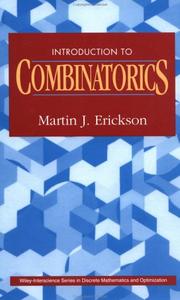Check nearby libraries
Buy this book

This gradual, systematic introduction to the main concepts of combinatorics is the ideal text for advanced undergraduate and early graduate courses in this subject.
Each of the book's three sections - Existence, Enumeration, and Construction - begins with a simply stated, first principle, which is then developed step by step until it leads to one of the three major achievements of combinatorics: Van der Waerden's theorem on arithmetic progressions, Polya's graph enumeration formula, and Leech's 24-dimensional lattice.
Along the way, Professor Martin J. Erickson introduces fundamental results discusses interconnection and problem-solving techniques, and collects and disseminates open problems that raise new and innovative questions and observations. His carefully chosen end-of-chapter exercises demonstrate the applicability of combinatorial methods to a wide variety of problems, including many drawn from the William Lowell Putnam Mathematical Competition.
Many important combinatorial methods are revisited several times in the course of the text - in exercises and examples as well as theorems and proofs. This repetition enables students to build confidence and reinforce their understanding of complex material.
- Mathematicians, statisticians, and computer scientists profit greatly from a solid foundation in combinatorics. Introduction to Combinatorics builds that foundation in an orderly, methodical, and highly accessible manner.
Check nearby libraries
Buy this book

Previews available in: English
Subjects
Combinatorial analysis| Edition | Availability |
|---|---|
|
1
Introduction to combinatorics
2013, John Wiley & Sons
in English
- Second Edition
1118637534 9781118637531
|
zzzz
|
| 2 |
aaaa
|
Book Details
Edition Notes
Includes bibliographical references (p. 187-189) and index.
"A Wiley-Interscience publication."
Classifications
The Physical Object
Edition Identifiers
Work Identifiers
Source records
Work Description
"Praise for the First Edition--"This excellent text should prove a useful accoutrement for any developing mathematics program. it's short, it's sweet, it's beautifully written." --The Mathematical Intelligencer"Erickson has prepared an exemplary work. strongly recommended for inclusion in undergraduate-level library collections." --ChoiceFeaturing a modern approach, Introduction to Combinatorics, Second Edition illustrates the applicability of combinatorial methods and discusses topics that are not typically addressed in literature, such as Alcuin's sequence, Rook paths, and Leech's lattice. The book also presents fundamental results, discusses interconnection and problem-solving techniques, and collects and disseminates open problems that raise questions and observations.Many important combinatorial methods are revisited and repeated several times throughout the book in exercises, examples, theorems, and proofs alike, allowing readers to build confidence and reinforce their understanding of complex material. In addition, the author successfully guides readers step-by-step through three major achievements of combinatorics: Van der Waerden's theorem on arithmetic progressions, Polya's graph enumeration formula, and Leech's 24-dimensional lattice. Along with updated tables and references that reflect recent advances in various areas, such as error-correcting codes and combinatorial designs, the Second Edition also features: Many new exercises to help readers understand and apply combinatorial techniques and ideas A deeper, investigative study of combinatorics through exercises requiring the use of computer programs Over fifty new examples, ranging in level from routine to advanced, that illustrate important combinatorial concepts Basic principles and theories in combinatorics as well as new and innovative results in the field Introduction to Combinatorics, Second Edition is an ideal textbook for a one- or two-semester sequence in combinatorics, graph theory, and discrete mathematics at the upper-undergraduate level. The book is also an excellent reference for anyone interested in the various applications of elementary combinatorics"--
Community Reviews (0)
History
- Created April 1, 2008
- 12 revisions
Wikipedia citation
×CloseCopy and paste this code into your Wikipedia page. Need help?
| August 2, 2024 | Edited by MARC Bot | import existing book |
| December 9, 2022 | Edited by ImportBot | import existing book |
| October 17, 2022 | Edited by ImportBot | import existing book |
| May 9, 2021 | Edited by ImportBot | import existing book |
| April 1, 2008 | Created by an anonymous user | Imported from Scriblio MARC record |









